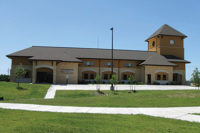It’s alarming that a modern city can run out of water, a reality that was on the brink of occurring in the city of Cape Town, South Africa.
Located at the southernmost tip of the African continent, Cape Town reached a critical state after two years of severe drought conditions. Some residents are even digging boreholes to find a source of water, which may be unfit for drinking.
How is this possible in an established city such as Cape Town? What can be done to help cities in a similar predicament?
One solution implemented in several coastal cities is saltwater desalination, a filtering process where salt is removed from water so that it is safe to drink. Whether the technology employed is reverse osmosis (RO desalination) or thermal distillation (stills), coming up with the technology to tackle the water shortage problem is only part of the solution. Like any other innovative design or improvement on existing technology, it is crucial that the finished product be evaluated to ensure public safety.
Cape Town’s coastline runs along 620 miles (1,000 km) of the Atlantic Ocean. Its location and access to saltwater makes this city a perfect candidate for saltwater desalination. Two temporary RO desalination plants are under construction. At an estimated cost of around $40 million U.S. (1/2 billion Rand), the plants are expected to supply up to 7 million gallons (26.5 million liters) a day for two years, after which they will be removed, and the area rehabilitated.
A close-to-ideal solution would be low-cost, highly efficient, compact stills or RO desalination units. However, low-cost solutions are traditionally cumbersome and require significant maintenance. Highly efficient systems are typically prohibitively expensive to construct and need a substantial energy investment per gallon of water produced.
Fortunately, we may be at the crossroads of low cost and high efficiency in our desalination technology. The increasing applications of these technologies, as well as the heightened interest driven by a need for solutions to the water shortage around the world, is moving the development and production of available products closer to the ideal solution.
How IAPMO can help
It is important in this burgeoning area that as products move into use they are tested to a standard to prevent failures and safeguard the health of the public. This is where IAPMO can become a factor. The IAPMO standards development procedures provide a means to rapidly develop new industry standards, to keep pace with evolving technology, and IAPMO R&T can provide testing and certification of a safe and reliable RO desalination unit or thermal still.
A municipal size desalination plant capable of generating 50 million gallons (190 million liters) of water a day is planned for construction in Huntington Beach, California. The cost is estimated at $1 billion U.S.; such a solution is financially unfeasible for most cities and individuals. However, a small still intended for use in individual households is not only financially feasible, but highly advisable when considered as one part of a plan to address an emergency water shortage. The Institute of Medicine recommends women drink around 0.5 gallons (2 liters) and men drink around 0.8 gallons (3 liters) of water a day. A still that produces 1 gallon (3.7 liters) of water per day per person would provide enough clean water for hydration, cooking and sparse bathing. A typical passive solar still can produce between 0.8 and 1.6 gallons (3 and 6 liters) of drinking water per day, per square meter of irradiation.
Water distillation, at its most basic, is how the natural water cycles work. Water evaporates and, when enough water vapor collects in the atmosphere, clouds are formed. When the clouds are saturated with moisture, water is released as rain. The concept of a still is similar. Saltwater is heated to accelerate evaporation in a chamber, and the distilled water vapor condenses on a surface and is then channeled to a collecting point such as a plate, channel or bottle. Although the concept of building a still is simple, there are many ways for it to be accomplished.
It is possible that the materials used for construction could contaminate the finished product. This is one issue that can occur with the purchase and use of uncertified products or products not certified for the intended use. There are several other potential issues that can be avoided through product certification, including poor workmanship or design leading to an unsafe product; improper function of a system out of the box due to a lack of quality control; and unclear directions or vague descriptions of the intended application of the product. Standards development and third-party product certification are a solution to these and other potential issues with this technology, as well as products in general.
IAPMO specializes in developing standards for new and innovative technologies. For example, IAPMO Codes and Standards just completed development of an industry standard for certification of alkaline water dispensers, and has developed standards for other innovative products, such as recirculating shower systems, and a test method for measuring the performance of drain water heat recovery units. A standard can be developed in as little as two months for an RO desalination unit, a still or other novel products that currently have no existing standards.
Developing industry standards for new and innovative products is where IAPMO standards development is at its best. Through our certified mark of conformity, IAPMO can help you stand out from the competition. Whether it is a new idea for a plumbing or mechanical product or an improvement to an existing technology, IAPMO has the expertise that can guide you in the right direction.
If you have designed a useful and practical, novel plumbing or mechanical device, and are interested in third-party certification to show the merits of your product, contact IAPMO at standards@iapmostandard.org.



